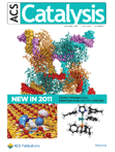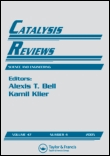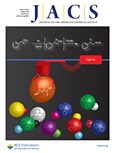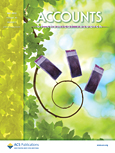
CATALYSIS SURVEYS FROM ASIA
Scope & Guideline
Pioneering Insights into Catalytic Processes and Applications
Introduction
Aims and Scopes
- Catalytic Mechanisms and Processes:
The journal publishes detailed studies on the mechanisms of catalysis, including reaction pathways and kinetics, providing insights into how catalysts function at the molecular level. - Synthesis and Characterization of Catalysts:
A significant focus is on the synthesis of new catalytic materials, including metal-based, metal-organic frameworks, and nanocatalysts, along with their characterization using advanced techniques. - Environmental and Sustainable Catalysis:
Research addressing catalysts that facilitate sustainable chemical processes, including waste minimization and the conversion of renewable feedstocks, is a core area. - Photocatalysis and Electrocatalysis:
The journal highlights studies on photocatalytic and electrocatalytic systems for energy conversion and environmental remediation, showcasing advancements in these rapidly evolving fields. - Applications in Fine Chemicals and Pharmaceuticals:
There is a consistent emphasis on the application of catalytic processes in the synthesis of fine chemicals and pharmaceuticals, indicating the journal's relevance to industrial applications.
Trending and Emerging
- Sustainable and Green Catalysis:
There is a marked increase in research focused on sustainable catalytic processes, including the use of renewable resources and environmentally benign methods, highlighting the journal's commitment to green chemistry. - Nanocatalysts and Nanomaterials:
The exploration of nanocatalysts, particularly those with enhanced surface area and reactivity, is a growing trend, indicating ongoing advancements in materials science and catalysis. - Electrocatalysis for Energy Conversion:
Research on electrocatalytic processes, particularly for fuel cells and renewable energy applications, is gaining traction, reflecting the importance of energy sustainability. - Photocatalytic Applications in Environmental Remediation:
The increasing focus on photocatalysis for the degradation of pollutants and environmental cleanup demonstrates a significant trend towards addressing environmental challenges through innovative catalytic solutions. - Integration of Artificial Intelligence in Catalysis Research:
Emerging studies incorporating AI and machine learning techniques for catalyst design and optimization are on the rise, indicating a modern approach to accelerating catalysis research.
Declining or Waning
- Traditional Homogeneous Catalysis:
While still relevant, there is a noticeable decline in the publication of studies focused solely on traditional homogeneous catalysts, as the field shifts towards more sustainable heterogeneous systems. - Conventional Catalytic Processes:
Papers discussing well-established catalytic processes without novel contributions or improvements are becoming less frequent, indicating a shift towards innovative and transformative approaches. - Simple Catalyst Characterization Techniques:
Research relying solely on basic characterization methods without integrating advanced techniques or comprehensive analysis of catalytic performance is waning. - Catalysis in Non-Green Chemistry:
Topics that do not align with green chemistry principles or sustainable practices are seeing decreased publication frequency, reflecting the growing emphasis on environmentally friendly approaches.
Similar Journals

Catalysis Science & Technology
Transforming Ideas into Catalytic SolutionsCatalysis Science & Technology is a leading journal published by the Royal Society of Chemistry, dedicated to advancing the field of catalysis through high-quality research and innovation. Established in 2011, this journal serves as a vital platform for researchers, professionals, and students interested in the latest developments in chemical engineering and catalytic processes. With an impressive Q2 ranking in Catalysis for 2023, the journal is recognized for its significant contributions to the discipline, evidenced by its respectable Scopus Rank of #21 out of 68 in the category and a 69th percentile standing. The journal is committed to disseminating original research that enhances our understanding of catalysis, facilitating knowledge exchange and collaboration within the scientific community. Even without Open Access, Catalysis Science & Technology remains pivotal in shaping innovations that drive forward both academic inquiry and industrial applications, making it an essential resource for anyone involved in this dynamic field.

ACS Catalysis
Exploring New Frontiers in Catalytic ScienceACS Catalysis, published by the American Chemical Society, stands as a premier journal in the field of catalysis, offering a vital platform for researchers, professionals, and students focused on advancing the science of catalysis and its applications. With an impressive impact factor placing it in the Q1 category for both Catalysis and Chemistry (miscellaneous), this journal has established itself as a leading source of high-quality research findings, currently ranking #21 out of 408 in General Chemistry and #9 out of 68 in Catalysis according to Scopus. Since its inception in 2011, ACS Catalysis has aimed to publish innovative research that addresses the critical challenges in catalytic processes, advancing our understanding of both fundamental and applied aspects of catalysis. With a commitment to promoting open scientific discourse, it serves a vital role for those interested in the latest methodologies, discoveries, and trends in this essential discipline. Based in Washington, DC, ACS Catalysis continues to uphold the highest standards of scholarship and collaboration within the vibrant community of chemists and engineers worldwide.

TOPICS IN CATALYSIS
Elevating the Standard of Catalysis ResearchTOPICS IN CATALYSIS is a renowned journal published by SPRINGER/PLENUM PUBLISHERS, dedicated to advancing the field of catalysis and its applications in chemistry and chemical engineering. With its ISSN 1022-5528 and E-ISSN 1572-9028, this journal has been a critical resource since its inception in 1994, encompassing a wide range of research topics and recent advancements within the realm of catalysis, including both fundamental studies and practical applications. As of 2023, it holds a prestigious Q3 ranking in Catalysis and a Q2 ranking in miscellaneous chemistry, reflecting its impact and relevance in the academic community. With a Scopus rank of #128 in General Chemistry and #38 in Catalysis, TOPICS IN CATALYSIS is positioned to be a key contributor to the ongoing dialogue in these fields, fostering innovation and collaboration. While not an open-access journal, it provides institutional access options, ensuring that the latest findings and methodologies are available to researchers, professionals, and students worldwide. This journal is essential for those looking to stay at the forefront of catalysis research and its transformative potential in science and industry.

ACS Organic & Inorganic Au
Elevating Research Standards in Chemical InnovationACS Organic & Inorganic Au, published by the American Chemical Society, stands as a premier open-access journal dedicated to advancing the fields of organic and inorganic chemistry. Since its inception in 2021, this journal has swiftly risen to prominence, achieving a commendable Q1 classification in Inorganic Chemistry, Organic Chemistry, and Physical and Theoretical Chemistry as of 2023. With an ISSN of 2694-247X, it provides a vital platform for researchers, professionals, and students to disseminate their findings and engage with cutting-edge work across converged disciplines. Operating from its headquarters in Washington, DC, ACS Organic & Inorganic Au is committed to fostering a collaborative research environment, encouraging rigorous peer review, and ensuring the wide accessibility of high-quality scholarly articles. With its open-access model, readers worldwide can freely access and utilize research findings, promoting a global exchange of knowledge crucial for driving innovation in chemistry.

CATALYSIS REVIEWS-SCIENCE AND ENGINEERING
Unleashing Innovation in Catalysis and EngineeringCATALYSIS REVIEWS - SCIENCE AND ENGINEERING, published by Taylor & Francis Inc, is a leading journal in the field of catalysis, providing a vital platform for the dissemination of rigorous research and comprehensive reviews from 1968 to the present. With an impressive Q1 ranking in multiple categories, including Catalysis and Chemistry, this journal stands out as an essential resource for professionals, researchers, and students alike. Its high impact factor and esteemed Scopus ranks — including 3rd in Chemical Engineering: Process Chemistry and Technology — highlight the journal's influence and prestige within the scientific community. While primarily a subscription-based publication, the journal’s commitment to advancing the understanding of catalytic processes continues to foster innovation in various industrial applications, making it indispensable for anyone engaged in the fields of chemical engineering and applied chemistry.

Reactions
Igniting Ideas for a Sustainable Future in ChemistryReactions is a dynamic open-access journal published by MDPI, dedicated to the advancement of research in the fields of Chemical Engineering and Chemistry. Launched in 2020, the journal aims to provide a platform for scientists and researchers to share their findings and innovations, facilitating the synthesis and dissemination of knowledge within the global academic community. With an impact factor that reflects its growing influence, Reactions ranks 47th in the Chemical Engineering category and 72nd in Chemistry on Scopus, placing it within the vibrant landscape of contemporary chemical research. Housed in the picturesque city of Basel, Switzerland, the journal is committed to open access, ensuring that its high-quality content is readily available to all. This commitment not only enhances visibility but also fosters collaboration among researchers, professionals, and students striving to push the boundaries of chemical sciences. As we look towards 2024 and beyond, Reactions continues to encourage submissions that explore groundbreaking methodologies, innovative applications, and transformative theoretical frameworks in chemistry and chemical engineering.

Bulletin of Chemical Reaction Engineering and Catalysis
Showcasing Transformative Insights in Chemical Reaction EngineeringBulletin of Chemical Reaction Engineering and Catalysis is a distinguished open-access journal published by UNIV DIPONEGORO, focusing on pivotal advancements in the fields of chemical reaction engineering and catalysis. Since its inception in 2008, this journal has served as a vital platform for disseminating cutting-edge research, catering to a diverse readership that includes researchers, professionals, and students in chemical engineering and related disciplines. With its dedication to publishing valuable insights, the journal has been indexed in Scopus and boasts respectable rankings across various categories, including Q3 in Chemical Engineering (miscellaneous) and Q4 in Catalysis as of 2023. It continues to foster scholarly dialogue and collaboration by providing an accessible means for contributors to share their findings. Operating from Semarang, Indonesia, this journal underscores its commitment to advancing knowledge in chemical sciences, making it an essential resource for those engaged in the study and application of chemical processes.

KINETICS AND CATALYSIS
Empowering Researchers in Chemical KineticsKinetics and Catalysis is a pioneering journal dedicated to advancing the field of catalytic science and chemical kinetics, published by Pleiades Publishing Inc. Based in the Russian Federation, this journal serves as a critical platform for disseminating high-quality research related to the mechanisms of chemical reactions and innovative catalytic processes. Although currently not an open access journal, it maintains academic rigor through a comprehensive peer-review process that ensures the relevance and integrity of its published works. With a history dating back to 1968, Kinetics and Catalysis has evolved through various converged years, reflecting its commitment to interdisciplinary research within the realms of chemistry, catalysis, and the computational aspects of modeling and simulation. As evidenced by its Scopus rankings and quartiles, it stands as an influential, albeit niche, journal, appealing to researchers, professionals, and students eager to explore the intricacies of chemical transformations. The journal’s robust archive offers an invaluable resource for those seeking to expand their understanding of both theoretical and practical approaches to catalysis.

Journal of the American Chemical Society
Advancing the Frontiers of Chemical KnowledgeJournal of the American Chemical Society (JACS), published by the American Chemical Society, stands as a pivotal publication in the field of chemistry, facilitating the dissemination of significant research findings since its inception in 1879. With an impressive impact factor and esteemed rankings placing it in the Q1 quartile across various categories—including Biochemistry, Catalysis, and Colloid and Surface Chemistry—JACS continues to serve as a vital resource for scientists, professionals, and students alike. Researchers choose JACS for its rigorous peer-review process, ensuring high-quality content that shapes the landscape of modern chemistry. The journal's extensive scope encompasses pivotal advancements and innovative methodologies, reflecting the evolving dynamics of chemical research. With access options being traditional subscription-based, it remains crucial for institutions and individuals to engage with its latest issues to stay at the forefront of chemical science advancement.

ACCOUNTS OF CHEMICAL RESEARCH
Exploring the Synergy of Chemical Research and HealthcareACCOUNTS OF CHEMICAL RESEARCH, published by the American Chemical Society, is a premier journal dedicated to advancing the field of chemistry and its applications in medicine. With an impressive impact factor and recognition as a Q1 journal in both chemistry and medicine categories, it ranks among the top-tier publications, exhibiting an outstanding Scopus rank of 8 out of 408 in general chemistry, placing it in the 98th percentile. This journal has been a vital source of innovative and significant research since its inception in 1968, and it aims to provide a platform for high-quality research articles, reviews, and critical essays that bridge the gap between chemical research and clinical implications. While it is not an open-access publication, the insights available in Accounts of Chemical Research are invaluable for researchers, professionals, and students seeking to explore the latest developments and interdisciplinary approaches within the dynamic fields of chemistry and medicine.